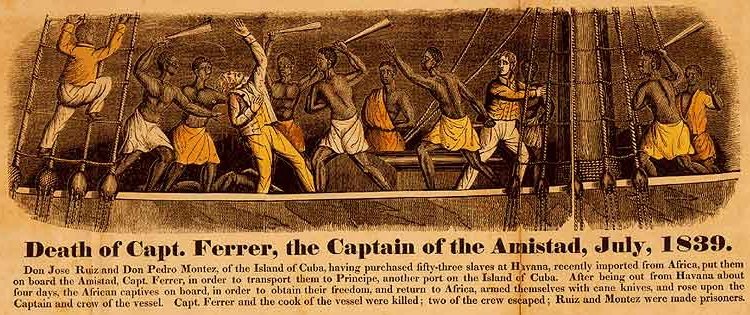
Frontispiece from John Warner Barber (1840). A History of the Amistad Captives.
On July 2, 1839, Sengbe Pieh (later known as Joseph Cinqué) led 53 fellow Africans being transported as captives aboard the Spanish schooner ‘La Amistad‘ from Havana in a revolt against their captors.
Breaking Free
La Amistad, captained by Ferrer, left Havana on June 28, 1839, for the small port of Guanaja, near Puerto Principe, Cuba, with some general cargo and 53 slaves bound for the sugar plantation where they were to be delivered. The captives had been taken in Africa by a Portuguese slaving ship and then smuggled into Havana under cover of nightfall, because this was a violation of an already existing treaty between Britain and Spain, which forbade trading in slaves. Although the United States and Britain had banned the Atlantic slave trade, Spain had not abolished slavery in its colonies. The crew of La Amistad, lacking purpose-built slave quarters, placed half the captives in the main hold, and the other half on deck. Off the northern cost of Cuba, the later leader of the insurgents, Sengbe Pieh (known in the Amistad trials as Joseph Cinqué), found a nail on deck with which he could free himself and the other Africans. They quickly ascended the stairs to deck and armed with machete-like cane knives they quickly over-powered the crew and killed the ship’s captain, the cook and possibly several other members of the crew. After successfully gaining control of the ship the captives demanded to be returned home.
Captured Again
But, the ship’s navigator deceived them about which direction their course was on and sailed the ship north along the North American coast to the eastern tip of Long Island, New York. On August 25 the now starving crew and mutineers anchored the ship off Long Island in search of provisions. Since the ship had been sighted several times in the past weeks and described as a pirate ship, the commander of Washington, Lieutenant Thomas Gedney, had received the order to look for a pirate ship with a black crew during his voyages off the US coast. Gedney had the Amistad boarded and the Africans, including the black slave Antonio, captured. They took the Africans to New Haven, Connecticut to be tried in court in a case that should become internationally well known.
A Test Case for the Principle of Natural Rights
The owners of the La Amistad argued that the captives had been slaves when purchased in Cuba so should be tried for piracy and murder, with the Spanish and Cuban Authorities demanding that the Americans return the ship and its human ‘cargo’. Anti Slavery campaigners rallied to the mutineers’ defence trying to prove that they had been unlawfully enslaved, because transporting slaves from Africa to the Americas was already outlawed by international treaty and therefore illegal at that time. Thus, it was seen as a test case for the principle of natural rights applying to black people.
The Verdict
The court case had become a case célèbre among abolutionists in the US. The slaves were charged with mutiny and murder. It was referred to the US district court and in January 1840 the court ruled that the mutineers had been illegally kidnapped and sold and had legally rebelled to win their freedom and ordered the return of the captives to Africa. The US Government had not expected this verdict and in May 1840 the judgement was upheld and the case was sent to the Supreme Court. Most agree that the Supreme Court was far from balanced with most of the court, including the judge being slave owners, although the defence did have former US president John Quincy Adams argue the case before the court. To the surprise of the government once again ruled in that the Africans had been illegally transported and held as slaves, and ordered them freed in March 1841. By November 1841 the surviving 35 Africans left the US for Sierra Leone under British Protection.
Also in popular culture the case of the La Amistad has become famous with the 1997 film directed by Steven Spielberg, who dramatized the historical incidents.[5] In Mystic, Connecticut a faithful replica of the Amistad was launched in 2000. On board the ship in its home port New Haven, Connecticut, the place of the first instance court hearing, schoolchildren today are informed about civil rights, slavery and racial discrimination.
Slavery, Ships and Sickness – Professor Stuart Anderson, [8]
References and Further Reading:
- [1] La Amistad at Britannica Online
- [2] La Amistad at Smithsonian
- [3] La Amistad at Cornell
- [4] La Amistad at Wikidata
- [5] Amistad at the Internet Movie Database
- [6] Amistad Trials 1839-1840
- [7] Works related to The Amistad at Wikisource
- [8] Slavery, Ships and Sickness – Professor Stuart Anderson, Gresham College @ youtube
- [9] “Teaching With Documents:The Amistad Case”. National Archives and Records Administration
- [10] Hunt, Bernice Kohn (1971). The Amistad mutiny. McCall Pub. Co. New York.
- [11] Owens, William A. (1997). Black Mutiny: The Revolt on the Schooner Amistad. Black Classic Press.
- [12] Timeline of mutinies, via DBpedia and Wikidata





